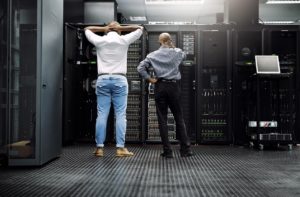Right now, downtime is a concern for nearly every business in all sectors. With shipping delays and material shortages at an all-time high, we are seeing a ripple effect of delays and shortages throughout the entire national (and international) marketplace.
Construction teams can’t finish houses due to lumber shortages. Vehicle manufacturers can’t complete their yearly production due to microchip shortages. Local restaurants are experiencing food delivery delays. Even tech companies can’t keep up with their schedules due to an IT labor shortage. Downtime can and often does come from delays outside of your control. But what about the downtime that is inside your control?
There is more to downtime than delays. A company experiences downtime any time that services or the ability to work is interrupted. Power outages, road-stopping storms, malware attacks, and even software upgrade failures can all cause downtime. how can your business build a sufficient business continuity plan to prepare for the most likely downtime risks for your sector, industry, and company?
Determine Your Downtime Risks
- Power and Internet Outages
- Shipping and Materials
- Extreme Weather
- Equipment and Software Failure
- Failed Software Upgrades
- Cybersecurity Attacks
Most companies have the highest risk of downtime in the face of digital and technical failures. Power and internet outages are the most profound. But human error, equipment failure, and even failed software upgrades can all take down your business systems at exactly the wrong moment. Cybersecurity poses a rising threat for all sectors while the widespread shortages (from lumber to IT technicians) creates an equally widespread risk of downtime as a result.
Determine which types of downtime are the biggest risk for your company. You don’t have to choose just one. Any significant risk-factor is worth preparing for to create your business continuity plan.
Build a Prevention Plan for Each Downtime Risk
- Backup and recovery planning
- Deeper inventory and early ordering
- Cloud-based data archives
- Third-party partner solutions
- Emergency generators and other fallback systems
Now that you have your list of downtime risks, start your prevention planning. A more robust network of backups and fallback systems are exactly what you need to make sure that if one thing goes wrong, your entire business isn’t brought to a halt.
This is your chance to build stronger systems, backup systems, and move many of your solutions to the cloud where a local disaster or device failure can’t damage your processes or backup systems. You might have a second internet provider, an emergency generator, or set up network monitoring so that system failures cannot happen without detection.
Third-party solutions are a great way to provide business continuity by networking your business functions.
Create Response and Recovery Plans: Red Folder Time
What happens if one of your major systems does go down? Your CRM upgrade eats itself and suddenly all your files are corrupted, or a shipment is delayed and production comes to a stop. What next? It’s time to build your red-folder file; your system of solutions should “the worst” happen in any possible circumstances.
Create a solution or network of solutions for every possible type of downtime. This is another place where third-party solutions are idea. It’s always a good idea to call for backup when your local systems are down and you need to keep the doors open and the phonelines on. You may have a bad-weather emergency generator service – those who deliver generators when the power goes out. You may have an IT team on-call to handle your software and hardware failures can be essential – especially if you don’t have on-staff IT to provide solutions.
Build robust backup and fallback systems. Find business continuity partners and work with third parties who can provide that fallback support when your business continuity is at risk.
Here at SystemsNet, we can help you prepare for business continuity for your hardware, software, and cybersecurity concerns. From backup recovery to software update protection, we’ll make sure your system and business stay online so you can focus on your other red folders like supply line and shipping concerns. Contact us today to take care of your technical business continuity planning with SystemsNet.



